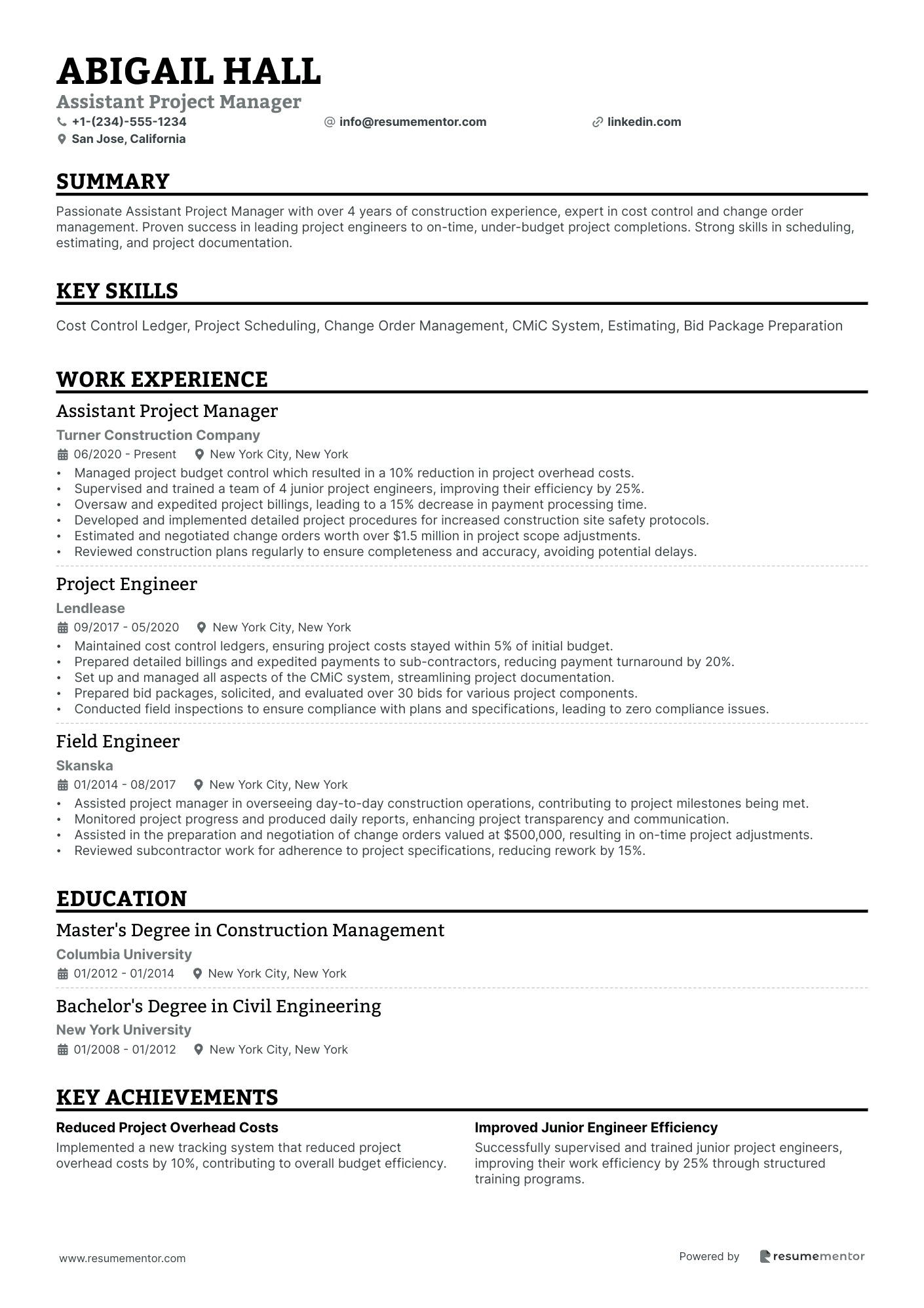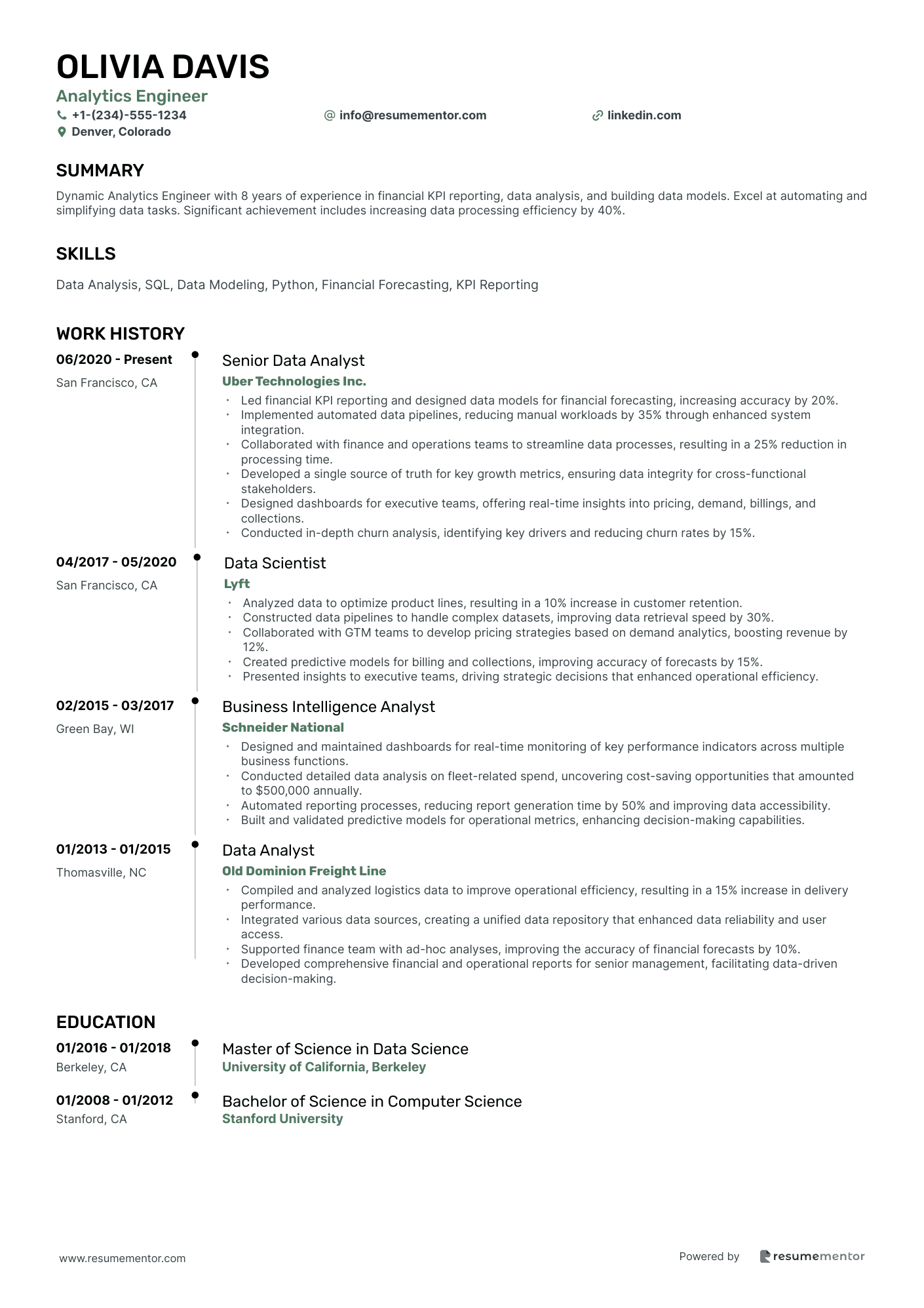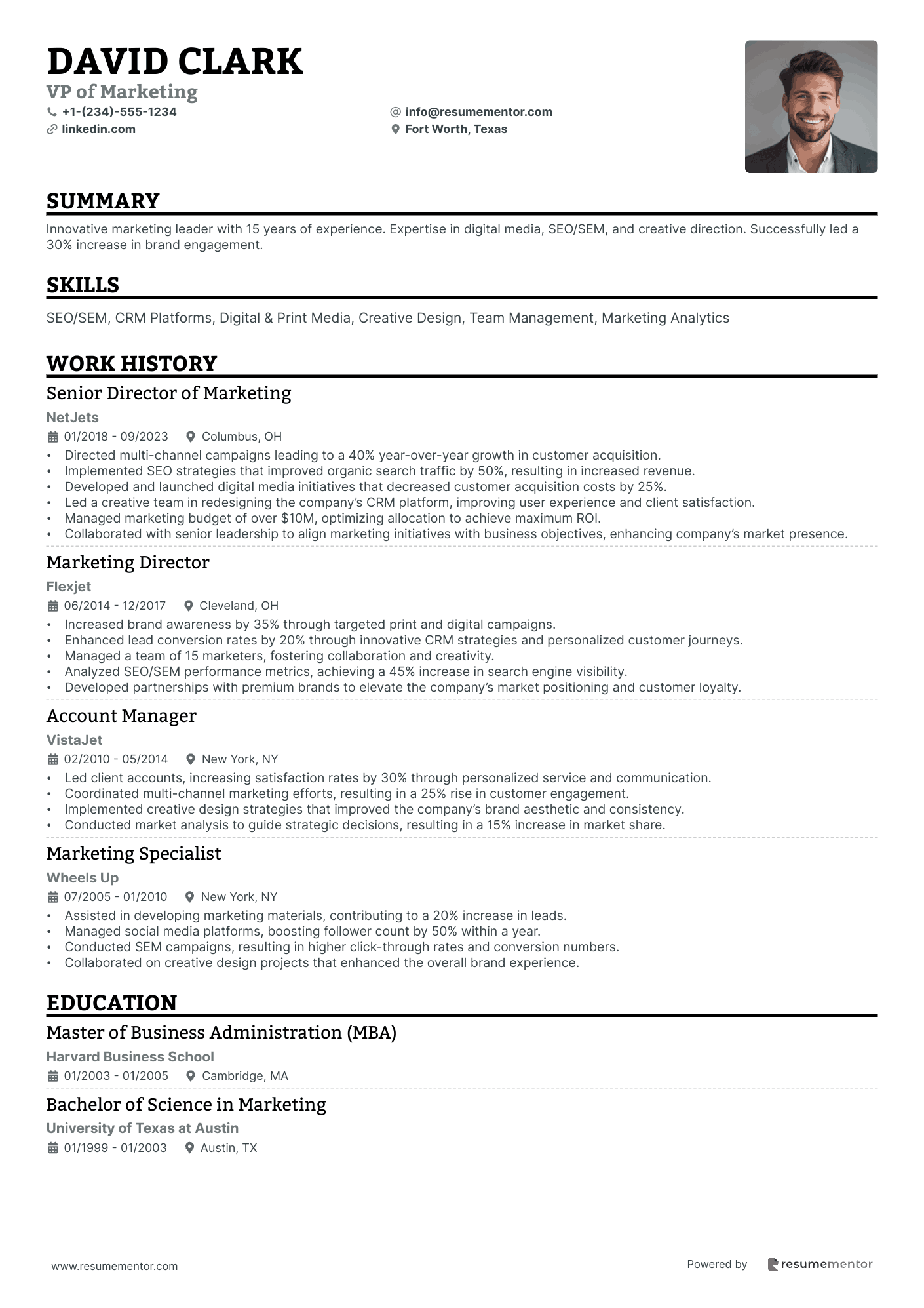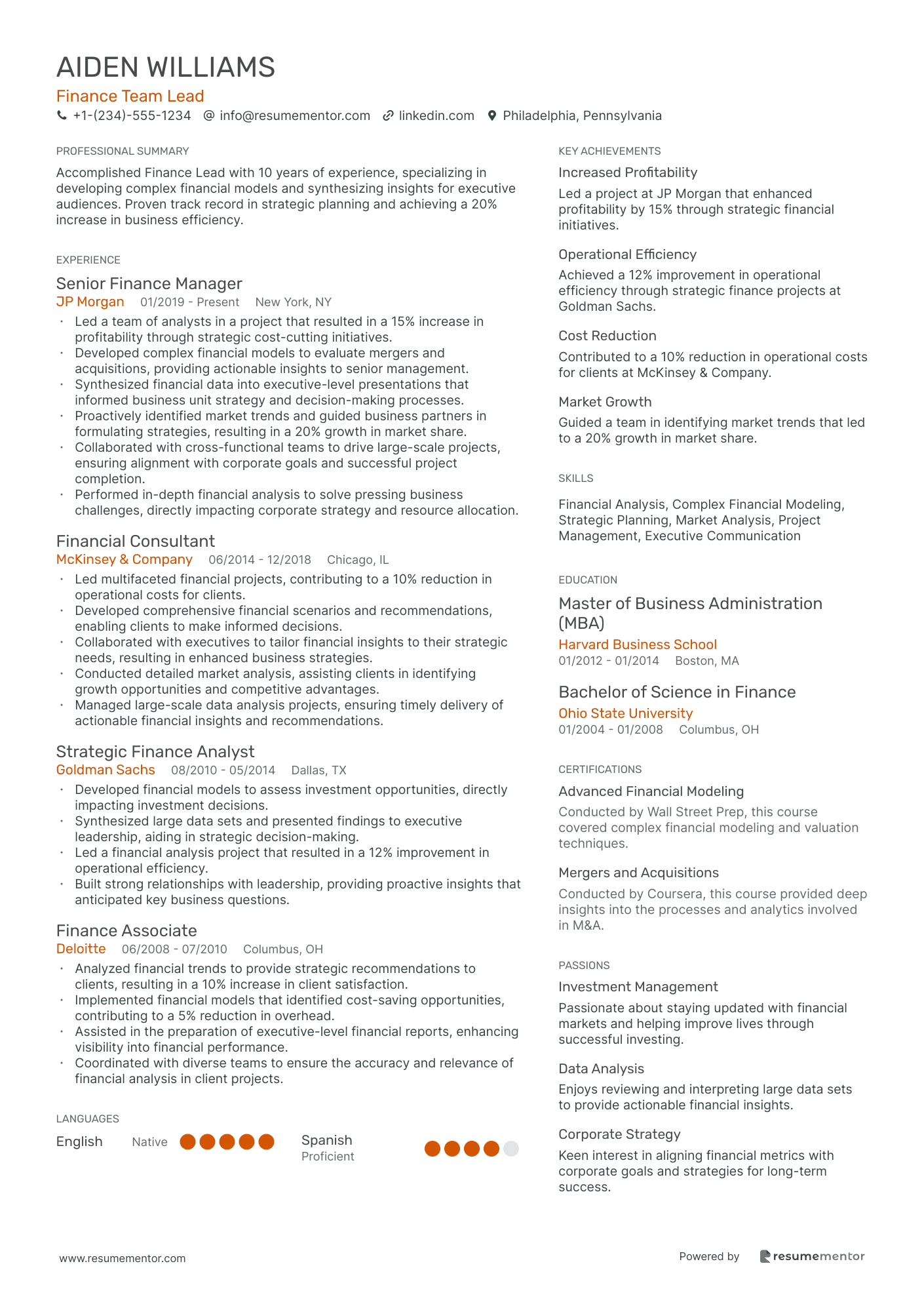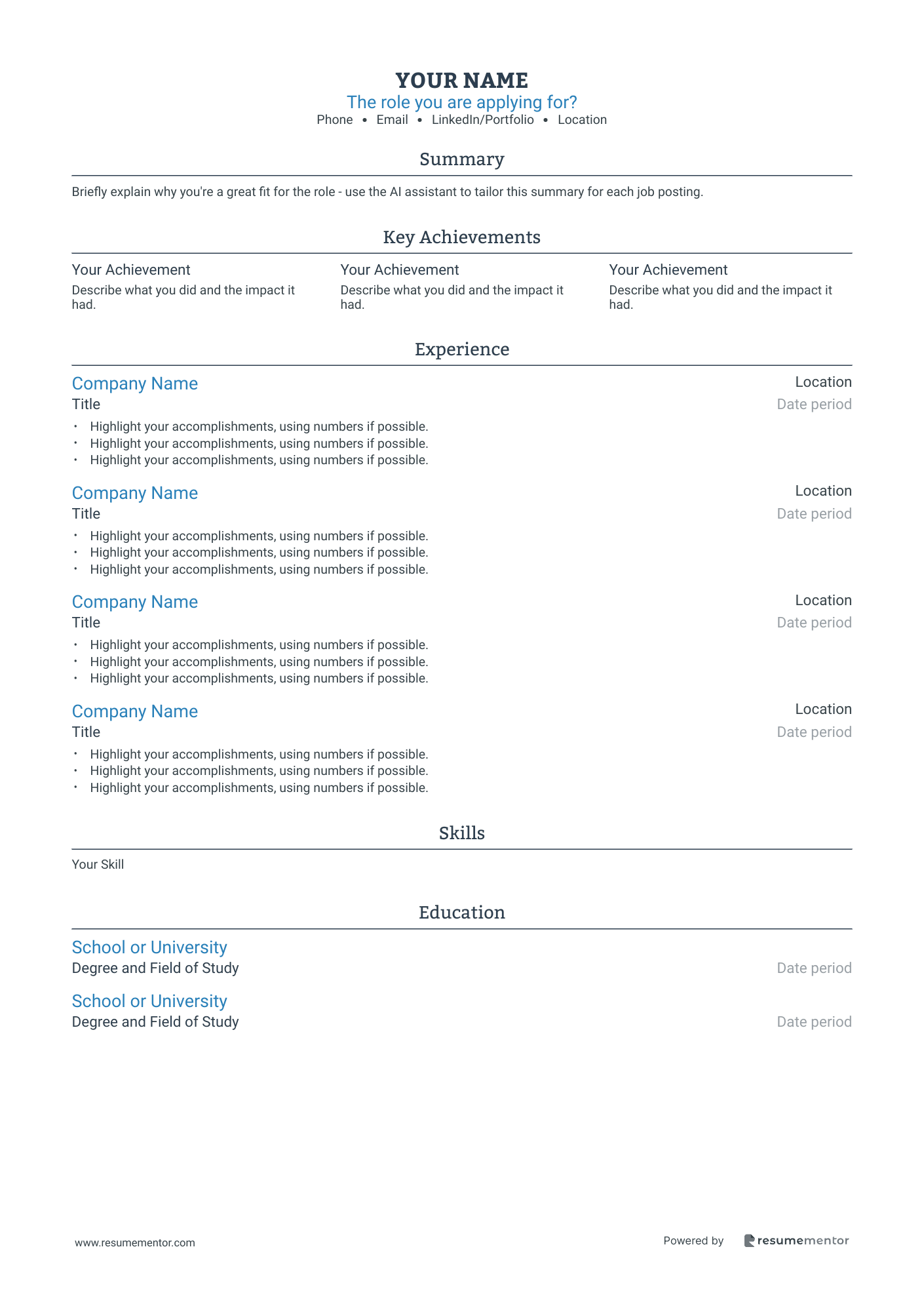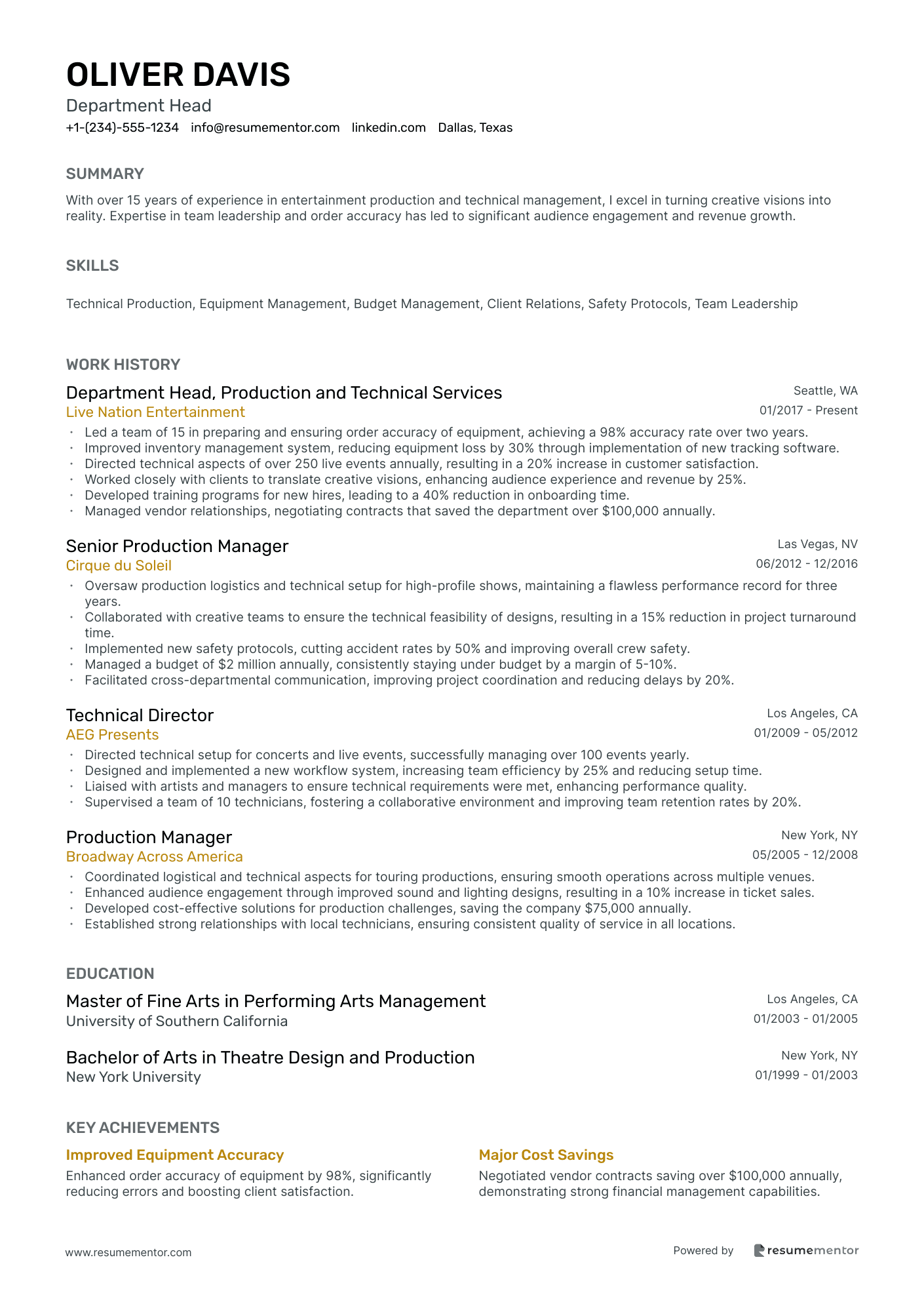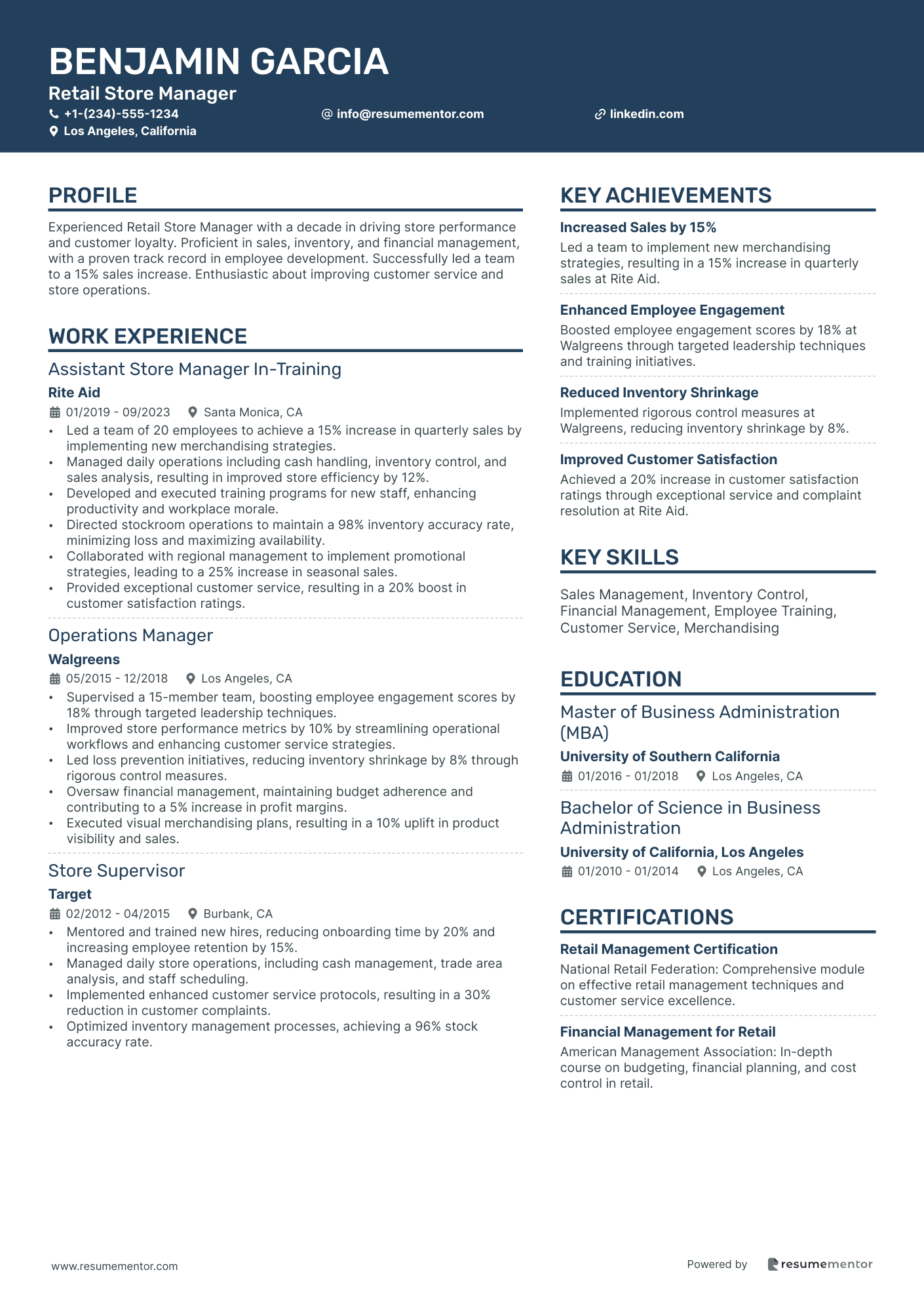Free Traditional Resume Templates
Learn how to create a professional, ATS-friendly traditional resume that stands out. Discover free editable traditional resume templates, formatting tips, examples, and when to use a traditional resume template for job applications.
Build My ResumeOur resumes get people hired at top companies
Black and white traditional resume template
The black and white resume template is a classic, like an old American movie. Its professional design emphasizes clarity and readability, making it a universal choice for any industry.
The minimalistic layout eliminates distractions and allows your achievements and experience to take center stage.
This template supports all essential resume sections, including header, summary/objective, work history, education, languages, and skills. You can also include additional sections like "Awards" and "Publications" to showcase your unique strengths.
Design specifications
- Format: A reverse-chronological format
- Margins: The template supports 1’’ and 0.5’’ margins
- Font: Rubik
- Font size: 10pt – 24pt
Simple traditional resume template
Simplicity is key to success, and this simple traditional resume template delivers just that. If you want a straightforward layout that ensures your information is presented clearly—this template is for you.
Its focus on functionality allows your experience and skills to impress recruiters. This template features all key resume sections like the header, summary/objective, work history, education, languages, and skills.
It's a modern version of traditional resume templates that have been trusted for years.
Design specifications
- Format: A reverse-chronological format
- Margins: The template supports 1’’ and 0.5’’ margins
- Font: Rubik
- Font size: 10pt – 24pt
Traditional resume template with a plain design
The Plain resume template is perfect for those just starting their careers and needing a clear format to showcase their qualifications. With its no-frills design, this template makes your information easy to read and ideal for entry-level roles.
It includes key sections like header, summary/objective, work experience, education, languages, and skills.
This template provides a solid foundation to tailor your resume for each job application, helping your submission look professional and well-organized.
Design specifications
- Format: A reverse-chronological format
- Margins: The template supports 1’’ and 0.5’’ margins
- Font: Rubik
- Font size: 10pt – 24pt
Condensed traditional resume template
Designed for those who need to fit a lot of information into a concise format, the Condensed resume template is ideal for professionals with extensive experience.
This template is designed to be both space-efficient and easy to read. It’s an excellent option for those working in both progressive and conventional sectors, including marketing, IT, education, finance, etc.
It includes all the important sections like the header, summary/objective, work history, education, languages, and skills. It also features additional sections like "Passions" to let your personality shine through.
Design specifications
- Format: A reverse-chronological format
- Margins: The template supports 1’’ and 0.5’’ margins
- Font: Rubik
- Font size: 10pt – 24pt
A blank traditional resume template
Our Blank resume template is for those who want to design their resume according to their own preferences. It offers a flexible foundation to customize and underline your qualifications and experiences.
This layout allows you to combine a stylish appearance with a professional tone.
It includes all essential sections such as the header, summary/objective, work experience, education, languages, and skills. We also suggest adding a few additional sections. Some of the most favored by recruiters are "Projects," "Achievements," and "Strengths."
Design specifications
- Format: A reverse-chronological format
- Margins: The template supports 1’’ and 0.5’’ margins
- Font: Rubik
- Font size: 10pt – 24pt
Single-column traditional resume template
Nothing says “classic” like the single-column resume template. It combines elegance and effectiveness. This layout is versatile and works perfectly for every industry and profession. It’s suitable for both seasoned professionals and those just starting their careers.
Recruiters trust the single-column template which makes it a smart choice. If you like to play it safe, this is for you. It includes key sections like the header, summary/objective, work history, education, languages, and skills.
If you'd like to make your resume more personal, think about adding sections like " Books" or "My life philosophy."
Design specifications
- Format: A reverse-chronological format
- Margins: The template supports 1’’ and 0.5’’ margins
- Font: Rubik
- Font size: 10pt – 24pt
A traditional resume template has stood the test of time. While modern and creative resumes have their place, the classic format remains a trusted choice for job seekers across industries. It’s been used for decades because it works—helping candidates present their qualifications clearly and professionally.
Despite changing hiring trends, employers still expect resumes that follow a familiar structure. A traditional format gives them exactly that. It provides a clean, no-frills way to showcase your skills, experience, and education without unnecessary distractions. This is why it’s still the go-to choice for professionals at all career levels, from entry-level applicants to senior executives.
Some may think traditional resumes are outdated, but they’re as effective today as they were years ago. Hiring managers appreciate their straightforward layout, and many industries, like finance, law, and healthcare, prefer them over trendier designs. They signal professionalism, making sure you’re taken seriously from the moment your resume is reviewed.
If you want a resume style that won’t go out of fashion, a traditional template is a smart choice. It’s a proven format that helps you make a strong impression and increases your chances of landing an interview.
Key takeaways
- A traditional resume template follows a structured, professional format that is widely accepted across industries.
- It prioritizes clarity and readability, using classic fonts, a simple layout, and minimal color.
- The reverse-chronological format is the best choice, listing your most recent job first to highlight career progression.
- Stick to professional fonts like Arial, Times New Roman, or Rubik, and avoid decorative or hard-to-read fonts.
- Use a neutral color scheme, with black for text and subtle dark gray or navy blue for headings. Avoid bright or neon colors.
- Write a strong summary statement that quickly highlights your experience, skills, and career goals in 2–3 sentences.
- Structure your work experience with bullet points that emphasize achievements and measurable results, not just job duties.
- Include a well-organized education section, listing degrees, relevant coursework (if applicable), and certifications.
- Highlight key skills by separating technical and soft skills, and tailor them to the job description.
- Ensure your resume is ATS-friendly by avoiding tables, columns, images, and non-standard section headings.
- Traditional resumes are best suited for formal industries like finance, law, healthcare, and government.
- Modern resumes incorporate design elements and color and are better suited for creative or tech-focused industries.
- When in doubt, a traditional resume is the safest choice, as it meets employer expectations and works well for most job applications.
- Always proofread and customize your resume for each job to maximize your chances of getting noticed.
What is considered a traditional resume
A traditional resume template follows a simple, time-tested format that puts your qualifications front and center. Employers are used to this style because it presents work experience, skills, and education in a clear, structured way. Instead of relying on flashy design, it focuses on readability and professionalism—two things that never go out of style.
What sets a traditional resume apart is its simple, no-frills design. Unlike modern resumes, which may use color and varied layouts, or creative resumes that incorporate graphics, a traditional resume keeps things classic. This makes it a safe and reliable choice, especially when applying to companies with formal hiring practices.
The design elements are clean and professional. Standard fonts like Rubik or Lato ensure readability, while a neutral color scheme keeps the focus on content. Each section is clearly labeled, following a predictable order—starting with your work history, followed by education and skills. This logical structure allows hiring managers to quickly find the information they need.
By sticking to a proven format, a traditional resume helps you stand out for the right reasons. It shows employers exactly what they need to see—without distractions—so they can focus on what really matters: your experience and skills.
When to use a traditional resume template
A traditional resume template is a smart choice in many situations because it provides a clear, structured way to present your experience. If you’re just starting your career, it helps you showcase your education, internships, and early work experience in a format that’s easy to follow. With limited experience, a well-organized layout ensures employers can quickly see your strengths and potential.
As you gain experience, this format continues to work in your favor. For mid-level professionals, it highlights career growth and key achievements without unnecessary distractions. Each role builds on the last, allowing hiring managers to see your progress at a glance. The same applies to senior executives, who often have years of experience to summarize. A traditional resume makes it easy to emphasize leadership roles, major accomplishments, and long-term impact while keeping the document readable.
This structured approach is also valuable for career changers. Switching industries can be challenging, but a clear, familiar format helps employers focus on your transferable skills rather than an unfamiliar work history. When information is well-organized, hiring managers can quickly understand how your past experience applies to the new role.
Some industries even expect this style. Fields like finance, law, healthcare, and government prioritize professionalism, and a simple, polished resume aligns with their hiring standards. Likewise, if you have a steady career path, this format presents it in the best possible way. Listing your experience in reverse-chronological order naturally highlights your consistency and growth.
No matter where you are in your career, a traditional resume makes it easy for employers to see what you bring to the table—without distractions. Its timeless structure keeps the focus on your qualifications, ensuring you make a strong impression.
✅ The benefits of using a traditional resume format
- Widely accepted – Works well across most industries, including conservative fields like finance, law, healthcare, and government.
- Easy to read – The structured layout makes it simple for recruiters to scan and find key information quickly.
- Professional appearance – A clean, polished design ensures a strong first impression.
- ATS-readable – Since it avoids complex graphics and unconventional layouts, it passes through Applicant Tracking Systems (ATS) without formatting issues.
- Logical structure – Follows a reverse-chronological order, making it easy to showcase career growth and steady work experience.
- No unnecessary distractions – Focuses on content rather than design, keeping the attention on your skills and experience.
- Ideal for career stability – Best suited for applicants with a consistent career path who want to highlight long-term experience.
- Recognized by employers – Familiar format that hiring managers expect and trust.
- Easy to update – Simple formatting makes it quick to add new experience and skills without needing a redesign.
- Time-tested and reliable – This format has been effective for decades and hasn’t gone out of style.
❌ The drawbacks of traditional resume templates
- Lacks creativity – May not stand out in creative fields like design, marketing, or media, where a visually unique resume could be an advantage.
- Not ideal for career gaps – The reverse-chronological format makes employment gaps more noticeable.
- Limited personal branding – Doesn’t allow much room for customization or personality compared to modern resume styles.
- Can feel generic – Since many job seekers use traditional templates, your resume may blend in rather than grab attention.
- Less flexibility for career changers – While it can highlight transferable skills, functional or hybrid resumes may work better for those shifting industries.
- May seem outdated in some industries – Certain tech or startup companies might prefer a more modern, visually engaging format.
- Strict formatting rules – Requires careful organization to ensure clarity, which may limit design choices.
- Minimal use of color or design elements – If used incorrectly, it can appear too plain or unremarkable.
How to create a traditional resume like a certified resume writer
A traditional resume is straightforward, but every section plays a key role in making you stand out. Below is a breakdown of how to craft each part with practical tips and examples.
Choose the right layout (reverse chronological is best)
The reverse-chronological format is the gold standard for traditional resumes. It lists your most recent job first and works backward, making it easy for hiring managers to see your career growth. This structure is familiar, widely accepted, and preferred in most industries. It allows employers to quickly assess your current experience and how it builds upon past roles.
✅ The chronological layout works for traditional resumes for:
- Candidates with a steady career history
- Professionals who want to showcase career growth
- Industries where work experience matters most (finance, law, healthcare, corporate roles)
🚫 Avoid the reverse-chronological format if:
- You have large career gaps (a functional or a combination resume might work better)
- You’re switching careers and need to highlight transferable skills first
A reverse-chronological resume follows a standard order that hiring managers expect. Here's an example:
- •Managed project budget control which resulted in a 10% reduction in project overhead costs.
- •Supervised and trained a team of 4 junior project engineers, improving their efficiency by 25%.
- •Oversaw and expedited project billings, leading to a 15% decrease in payment processing time.
- •Developed and implemented detailed project procedures for increased construction site safety protocols.
- •Estimated and negotiated change orders worth over $1.5 million in project scope adjustments.
- •Reviewed construction plans regularly to ensure completeness and accuracy, avoiding potential delays.
- •Maintained cost control ledgers, ensuring project costs stayed within 5% of initial budget.
- •Prepared detailed billings and expedited payments to sub-contractors, reducing payment turnaround by 20%.
- •Set up and managed all aspects of the CMiC system, streamlining project documentation.
- •Prepared bid packages, solicited, and evaluated over 30 bids for various project components.
- •Conducted field inspections to ensure compliance with plans and specifications, leading to zero compliance issues.
- •Assisted project manager in overseeing day-to-day construction operations, contributing to project milestones being met.
- •Monitored project progress and produced daily reports, enhancing project transparency and communication.
- •Assisted in the preparation and negotiation of change orders valued at $500,000, resulting in on-time project adjustments.
- •Reviewed subcontractor work for adherence to project specifications, reducing rework by 15%.
❌ Common mistakes to avoid when using the reverse-chronological resume format:
- Skipping dates: Leaving dates out makes it look like you’re hiding employment gaps.
- Listing jobs out of order: Always put the most recent role first.
- Too much detail on old jobs: Focus on recent positions—hiring managers care more about what you’ve done in the last 5–10 years.
If your work history is steady and you want to emphasize career progression, the reverse-chronological format is the best choice. It keeps your resume structured, professional, and easy to follow.
Pick a professional font
The font you choose for your resume affects readability, professionalism, and first impressions. A traditional resume should use a clean, easy-to-read font that looks polished on both digital screens and printed copies. Hiring managers spend only a few seconds scanning resumes, so your font should make it effortless for them to absorb key details.
Best font choices for a traditional resume
- Lato – Modern and widely used, offering excellent readability.
- Volkhov – A classic serif font often associated with professionalism.
- Rubik – A contemporary sans-serif font that balances clarity with a polished look.
If you’re using Microsoft Word to build your resume (don’t, because Resume Mentor’s resume builder is 100% free with unlimited edits and downloads) just stick to Arial and Times New Roman.
Font size recommendations:
- Name/Header: 16–20 pt (Make your name stand out.)
- Section headings: 12–14 pt (Use bold for emphasis.)
- Body text: 10–12 pt (For readability, don’t go smaller than 10 pt.)
❌ Common mistakes to аvoid:
- Using a font that’s too decorative or difficult to read. Stick to traditional, professional choices.
- Inconsistent font usage. Using different fonts across sections makes your resume look disorganized.
- Font size too small or too large. Anything below 10 pt is too tiny, and anything above 14 pt (for body text) looks unprofessional.
- Using colored text for no reason. Black text is the standard; muted shades like navy blue or dark gray can be used sparingly for section headings.
A professional font ensures your resume looks polished and easy to read at a glance. Keeping it clean and consistent helps recruiters focus on what really matters—your skills and experience.
Use a neutral color scheme
A traditional resume should prioritize professionalism and readability, which means keeping colors subtle and minimal. While modern resumes might experiment with bright colors and bold accents, a classic resume sticks to a neutral color scheme that keeps the focus on your qualifications.
Best color choices for a traditional resume
- Black – Standard for body text; ensures maximum readability.
- Dark Gray (#333333) – Works well for headings to create subtle contrast.
- Navy Blue (#003366) – A professional alternative for section titles.
- Deep Burgundy (#800020) – A refined, non-distracting color for name or subheadings.
Using a slight color variation for headings can add a touch of refinement without overwhelming the document. However, it should never take attention away from the content.
🚫 Colors to avoid
- Bright Red, Yellow, or Green – Can look unprofessional or distracting.
- Neon shades – Hard to read on digital screens and printed copies.
- Light Gray or pastels – May not provide enough contrast for readability.
Common mistakes to avoid:
- Using too many colors. Stick to one or two neutral accent colors at most.
- Bright or neon colors. They can make text harder to read and look unprofessional.
- Light gray or pastel text. It may look elegant on screen but often prints poorly.
- Overuse of color in text. The best place for color is headings, your name, or subtle section dividers—not body text.
A traditional resume should feel polished and professional. A clean black-and-white layout with subtle accents will always be more effective than one overloaded with unnecessary colors. Keep it simple, and let your experience do the talking!
Write a strong summary statement
Your summary statement is the first thing a recruiter sees, so it needs to make an impact. In just 2–3 sentences, you should highlight your key skills, experience level, and career goals. Think of it as your elevator pitch—it should immediately tell employers why you’re a strong candidate for the job.
A traditional resume summary is straightforward and avoids unnecessary fluff. It’s not an objective statement (e.g., “Looking for a job in marketing”) but rather a brief, compelling introduction that shows what you bring to the table.
How to write a strong summary statement
- Start with your experience level and expertise.
Example: “Marketing professional with 6+ years of experience in digital strategy and content marketing.” - Highlight key skills or specializations.
Example: “Skilled in SEO, email marketing, and social media strategy to drive brand engagement.” - Include a career achievement or measurable result (if possible).
Example: “Proven track record of increasing website traffic by 40% and boosting conversion rates through targeted campaigns.” - Tailor it to the job you’re applying for.
Example: “Seeking to apply expertise in growth marketing to help [Company Name] expand its digital reach.”
🚫 Common mistakes to avoid when writing your traditional resume summary
- Being too vague. Your summary should be specific about your skills and experience.
- Using first-person pronouns. Keep it professional—avoid “I” or “my.”
- Listing soft skills without proof. Instead of saying you’re “detail-oriented,” show it with an achievement.
- Making it too long. Keep it to 2–3 sentences; anything longer becomes a paragraph recruiters won’t read.
A strong summary statement sets the tone for your resume. It should be clear, confident, and tailored to the role you’re applying for. When done right, it grabs attention and encourages hiring managers to keep reading
Structure work experience properly
Your work experience section is the heart of your resume. It’s where employers look first to understand your career history, skills, and impact. A well-structured work experience section doesn’t just list job duties—it highlights achievements, responsibilities, and measurable results in a way that’s easy to scan.
A traditional resume follows a reverse-chronological format, meaning you list your most recent job first and work backward. Each job entry should include:
- Job title – Shows your role and level of responsibility.
- Company name and location – Clearly identifies where you worked.
- Dates of employment – Helps employers see your career timeline.
- Key responsibilities and achievements – Focus on what you accomplished, not just what you were assigned.
- Metrics and results – Quantify your impact whenever possible (e.g., “Increased revenue by 20%”).
- •Developed and managed digital marketing campaigns, increasing customer engagement by 35% in one year.
- •Led a team of three to execute content strategies, boosting website traffic by 40%.
- •Optimized ad spend, reducing costs by 15% while maintaining conversion rates.
- •Assisted in content creation and email marketing, leading to a 25% increase in customer retention.
- •Conducted market research to refine social media strategy, growing followers by 20%.
Best practices for writing a resume work experience section
- Use bullet points – Hiring managers skim resumes quickly. Keep points short and action-oriented.
- Start each bullet point with a strong action verb – Use words like “Led,” “Increased,” “Optimized,” “Developed,” “Implemented.”
- Focus on results, not just duties – Employers want to see what you achieved, not just what you were responsible for.
- Use numbers and metrics whenever possible – Data makes your contributions more tangible.
🚫 Common mistakes to avoid when writing an experience section
- Listing job duties instead of achievements. Instead of saying “Managed social media accounts,” say “Grew social media engagement by 30% through targeted campaigns.”
- Using vague language. “Helped with sales” doesn’t tell the employer what you actually did.
- Skipping dates or job titles. This creates confusion and can make it seem like you’re hiding employment gaps.
- Using too many bullet points. Stick to 3–5 key points per job to keep it readable.
Your work experience should tell a story of your career growth and prove your impact in each role. The clearer and more results-driven your work history is, the stronger your resume will be.
Include an education section
Your education section helps employers understand your academic background and any relevant training. While it’s especially important for entry-level candidates, mid-level and senior professionals should still include it to establish credibility.
A traditional resume follows a clear and structured format for education:
- Degree earned – Bachelor’s, Master’s, or other qualifications.
- Field of study – Your major or area of expertise.
- University name and location – The institution where you studied.
- Graduation year – Optional for experienced professionals.
- Honors, certifications, or relevant coursework – If applicable.
- •Relevant Coursework: Digital Marketing, Consumer Behavior, Data Analytics
- •Dean’s List (2021, 2022)
- •Google Analytics Certified
Pro tip
Best practices for the education section
- Keep it structured and consistent – Use the same formatting as your work experience.
- Include relevant certifications – Especially if they’re required for your industry (e.g., CPA for accountants, Google Ads for marketers).
- Only include high school if you don’t have a higher degree – Once you’ve earned a college degree, high school details are unnecessary.
- List honors and achievements selectively – Only include awards if they add value to your resume.
🚫 Common mistakes to avoid when adding education to your traditional resume
- Listing irrelevant or outdated coursework. Employers care more about your professional skills than the specific classes you took years ago.
- Including unnecessary details. No need to list extracurricular activities unless they’re directly related to the job.
- Adding fake degrees or certifications. Many employers verify educational background, and lying can get you disqualified.
- Using inconsistent formatting. Keep font sizes, spacing, and order aligned with the rest of your resume.
Your education section should be clear, concise, and tailored to your level of experience. Whether you’re a recent graduate or a seasoned professional, keeping it well-structured ensures it adds value to your resume!
Highlight key skills (technical and soft skills)
Your skills section is one of the quickest ways for employers to see what you bring to the table. A well-organized skills list helps recruiters and hiring managers identify whether you’re a good fit for the job in just a few seconds.
A traditional resume groups skills into two categories:
- Hard (technical) skills – Job-specific skills like software proficiency, data analysis, coding, or financial modeling.
- Soft skills – Interpersonal abilities like leadership, communication, or problem-solving. While important, soft skills should generally be demonstrated in your work experience rather than just listed.
Pro tip
Tailor your skills section to match the job description. If a company is looking for experience with Excel and financial modeling, make sure those are listed under your technical skills.
Best practices for the skills section
- Prioritize technical skills – These are what recruiters and ATS (Applicant Tracking Systems) scan for.
- Match your skills with the job description – Use relevant keywords to improve ATS compatibility.
- Keep it concise – Aim for 6–10 key skills that align with the job.
- Use clear formatting – Separate technical and soft skills for readability.
🚫 Common mistakes to avoid when listing skills on your traditional resume:
- Listing outdated or irrelevant skills. If you haven’t used a technology in years, don’t include it.
- Adding too many soft skills. Instead of saying you’re “good at teamwork,” show it in your work experience.
- Being too broad. “Microsoft Office” is vague—if Excel is important, list “Advanced Excel (Pivot Tables, VLOOKUP)” instead.
- Overloading the section. Stick to the most relevant skills; listing 20+ makes it look cluttered.
A strong skills section helps employers quickly see why you’re qualified. Keeping it specific, structured, and tailored to the job will make your resume stand out!
Use standard section headings for ATS and readability
Most companies today use Applicant Tracking Systems (ATS) to screen resumes before a recruiter even sees them. If your resume sections aren’t named correctly, the ATS might have a hard time recognizing your skills and experience, which means your application could be rejected automatically—even if you’re qualified for the job.
A traditional resume naturally aligns with ATS best practices, but there are still some formatting rules you should follow to ensure both the system and human recruiters can read it properly.
The ATS scans for familiar headings like:
- Work Experience (not “Where I’ve Worked”)
- Education (not “My School Journey”)
- Skills (not “What I’m Good At”)
Pro tip
Submit your resume in the right file format
Most ATS systems process Word (.docx) and PDF files correctly. However, a Word file is usually one you’d want to avoid.
While you can make edits easily, Word files don’t preserve your formatting, so if a recruiter doesn’t have MS Word installed (an expensive licensed software mind you) then you can say goodbye to getting a callback.
✅ Best file formats
- .pdf (Best file for resumes as it preserves formatting and it’s fully ATS-compatible)
🚫 Avoid
- .docx (Loses formatting, requires a licensed software)
- .jpg or .png (ATS can’t read images)
- .txt (Loses formatting)
- Google Docs link (Always download and submit as a file)
Traditional resume template vs. modern resume template
When applying for jobs, choosing the right resume format can make a big difference. Traditional and modern resumes serve different purposes, and picking the right one depends on your industry and career goals.
Traditional resume example
A traditional resume follows a structured, easy-to-read format. It uses classic fonts, a simple layout, and minimal color to keep the focus on your experience and skills. This type of resume is best for formal industries like finance, law, healthcare, and government, where professionalism is expected.
Modern resume example
A modern resume, on the other hand, introduces subtle design elements, color accents, and varied layouts to make your application stand out. It often includes sections like “Personal Projects” or “Technical Skills” to showcase more than just work history. This format works well for creative and tech-driven industries such as marketing, design, and startups, where innovation is valued.
The biggest difference between the two is presentation. Traditional resumes are straightforward and no-nonsense, while modern resumes add a bit of personality without going overboard. If you’re applying to a conservative company, a modern resume could come across as unprofessional. But in a creative field, a plain, text-heavy resume might seem outdated.
Use a traditional resume if you want to highlight a strong, steady career path with clear job progression. Choose a modern resume if you need to emphasize skills, projects, or unique experiences that don’t fit neatly into a standard format.
If you’re unsure, always check the company’s culture and industry norms. A well-designed modern resume can help you stand out, but when in doubt, a traditional resume is always a safe choice.
In conclusion
A traditional resume template remains one of the most reliable ways to present your qualifications. Its clean, structured layout ensures that hiring managers can quickly find the information they need without distractions. Whether you’re an entry-level job seeker, a seasoned professional, or transitioning careers, this format helps you highlight your experience and skills in a way that is both professional and effective.
While modern resumes have their place in creative and tech-driven industries, a traditional resume is a safe and strategic choice for most job applications. It aligns with employer expectations, works well with applicant tracking systems, and keeps the focus on what truly matters—your expertise and career achievements.
No matter where you are in your job search, the key to success is tailoring your resume to the role you want. Keep your formatting simple, emphasize your accomplishments, and ensure your document is easy to read. A well-crafted traditional resume won’t just get past screening software—it will also make a strong impression on recruiters and hiring managers.
At the end of the day, substance matters more than design. A traditional resume helps you stand out for the right reasons, making sure your experience and skills take center stage. If you follow the best practices outlined in this guide, you’ll have a polished, professional resume that increases your chances of landing the job you want.
Communicate your creativity with the right resume template
Pick a template:
Personalize it:
Save and download:
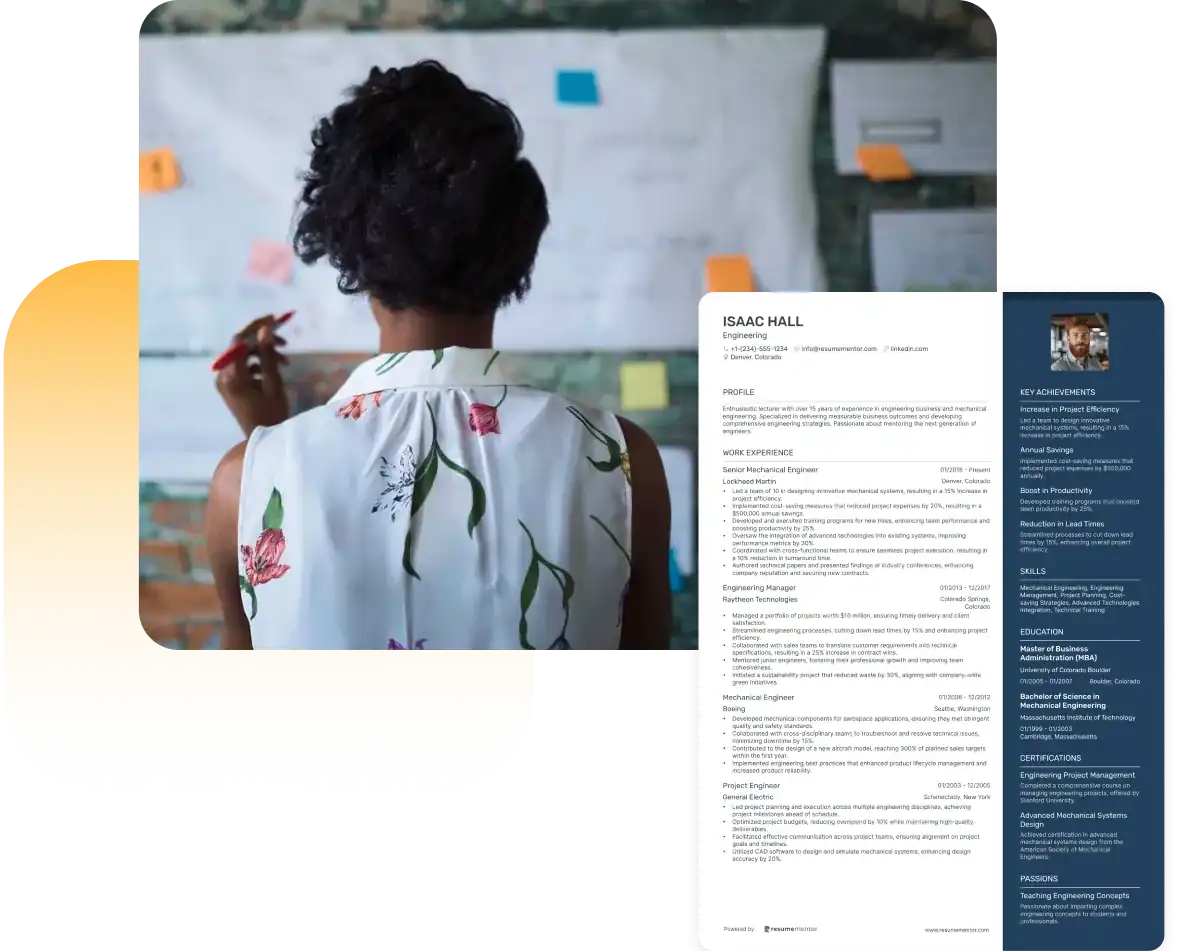
Frequently Asked Questions
What’s a traditional resume format?
This type of format lists your work history starting with the most recent job, showing titles, companies, dates, and key duties. It includes sections like contact information, a summary or objective, work experience, education, and relevant skills. This clear and organized layout is widely accepted, making it easy for recruiters to see your career journey and qualifications.
Who should choose a traditional resume template?
They suit most professions but are preferred in conservative industries like finance, law, government, and healthcare.
How can I make my resume stand out with a traditional template?
Craft a compelling summary, quantify your achievements, and tailor it for each job. Use strong action verbs, ensure consistent formatting, and include industry-specific keywords. This approach will help you present a clean, professional, and impactful resume that catches the eye of potential employers.
How do you express creativity on a traditional resume?
Be cautious about being too creative with your traditional resume, as recruiters may not take it seriously and might skip it. Instead, demonstrate your creativity through the skills, experiences, and qualifications detailed in each section. For example, if a job requires expertise in Agile methodology, emphasize your accomplishments in leading successful Agile projects to make your experience more relevant.
What’s the difference between a traditional resume and a functional resume?
A traditional resume focuses on work history, listing jobs in reverse chronological order, and underscoring job titles, companies, and dates. It suits those with steady career progression.
A functional resume, however, emphasizes skills and abilities over specific job history, making it ideal for career changers, those with employment gaps, or diverse experiences. It highlights strengths and relevant skills regardless of job timing.
In the entertainment business, when will you need a traditional resume?
In the entertainment business, a traditional resume is needed for administrative roles, corporate positions, and technical jobs like engineers. These roles require a clear presentation of experience, skills, and achievements, making it easier for hiring managers to assess your fit for the job.
What’s the price of traditional resume templates?
Resume Mentor’s traditional templates are free to edit and download!
Resume
Resources
Tools
© 2025. All rights reserved.
Made with love by people who care.
